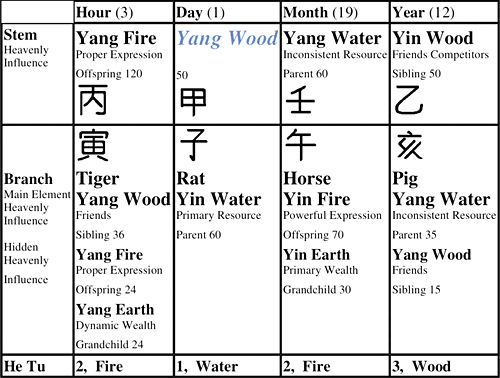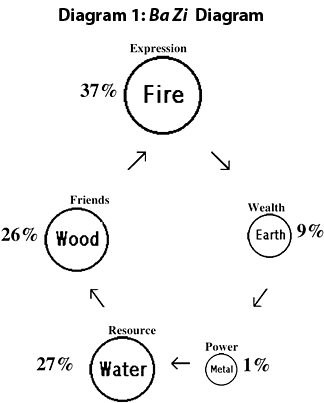The classic Chinese medical text the Su Wen presents seven internal causes of illness. These causes are emotions related to the organs: sadness, grief, pensiveness, fear, fright, anger and joy.
Emotions are qi. When emotions are imbalanced they can alter the way qi flows. Emotions not only influence their own organ's qi flow, they can alter the qi of related organs in their five phases relationships. For instance, if a person suffers from anger, the Liver can overact on Earth and cause the Spleen to suffer from worry, its corresponding emotion. When the Liver overacts on the Spleen, its associated emotion worry can cause qi to be stagnant and not flow upward causing physical and emotional conditions. Understanding emotions and the qi allows for the clinician to use numerous methods to balance qi and the emotion. In addition to the standard diagnostic methods used in modern Chinese medicine, a classic method called ba zi or the eight characters of birth can be used to identify constitutional organ and emotional conditions.
Chapter 1 and 2 of the Su Wen presents two major cycles of time: seven and eight-year cycles and seasonal cycles. The Su Wen and Ling Shu contain many references to cycles of time. Understanding nature's cycles and their influence on life is a lost method in modern times. The building blocks of the Chinese calendar are the celestial stems and terrestrial branches are presented in Su Wen chapter 66, Energy Almanac. In chapters 66-74 of the Su Wen a unique system of how cycles of time are related to atmospheric influences (climatic pathogenic factors) is presented. Those chapters present a magnificent insight for understanding yearly energy cycles and the pathogens produced by them.
The atmospheric influences generated each year can trigger constitutional imbalances; they can be an activator of pre-existing conditions. The Five Phases Circuits, chapter 67 of the Su Wen, presents the relationship between stems and branches and atmospheric influences; table 1 presents the relationships.
Table 1: Stems, Branches & Atmospheric Influences
| Stems | Ruled by | Branches | Six Stage | Atmospheric Influences |
| Yang Wood Yin Earth |
Earth Dampness |
Ox & Sheep | Tai Yin |
Dampness |
| Yang Metal Yin Wood |
Metal Dryness |
Rabbit & Rooster | Yang Ming | Dryness |
| Yang Fire Yin Metal |
Water Cold |
Dragon & Dog | Tai Yang | Cold |
| Yang Water Yin Fire |
Wood Wind |
Pig & Snake | Jue Yin |
Wind |
| Yang Earth Yin Water |
Fire Heat |
Rat & Horse | Shao Yin | Heat |
| Yang Earth Yin Water |
Fire Heat |
Tiger & Monkey | Shao Yang | Heat |
2012 is a Yang Water, Dragon year. Yang water generates wind and the dragon generates cold. The combination of the stem and branch generates an atmospheric influence of wind and cold. People susceptible to exterior pathogenic wind cold attacks may find this year they struggle with this condition. A person with excess cold will find this year exacerbates the condition. Someone with internal wind, liver yang rising and hypertension may find those conditions intensifying this year. Using this knowledge to develop a preventative wellness plan of qi gong, herbal medicine, acupuncture and nutrition is applying Chinese medicine in the light of the early developers of the medicine.
Stems and branches can be applied in many ways in the Chinese healing and divination arts. One method is to find the stems and branches of birth. This is called ba Zi or the eight characters of birth. This is the stem and branch of the hour, day, month and year of birth. A ba zi or birth chart contains one's birth or constitutional condition. It is a way to perceive prenatal influences and identify constitutional susceptibilities. I have found medical ba zi to be a very effective diagnostic method.
Table 2 is a ba zi chart. It is also called the four pillars and it is of a well-known spiritual teacher. The four pillars are comprised of stems and branches (Chinese zodiac animals), which contain five phases. The four pillars can be converted into a five phases diagram, reflecting the five phases birth condition (see diagram 1). The diagram illustrates there is an excess of fire and a deficiency of metal and earth. Because water nourishes wood and there is deficient metal to control wood, we can say there is a predominant amount of wood and fire. The constitutional diagnosis would include excess wood and fire and a treatment plan would include treating both. Additionally, fire would overact on metal creating metal conditions from this interaction.
Table 2: Four Pillars Chart

 From a five shen perspective, the four pillars diagram shows this person was born to express their heart shen. The person would be involved in spiritual interests. The combination of fire and wood is 63 percent of the chart, their purpose in life is clear, to follow their heart shen. Additionally, with the lack of Earth and metal, which represent the physical world, this person's purpose is to bring their spiritual insight and lifestyle into this world, into this current life. From a medical perspective, this person would need to balance the Earth and metal systems, to build them up and to reduce excess fire. These systems should be checked on an ongoing basis. Qi Gong, meditation, nutrition, herbal medicine and acupuncture plans would be developed to balance the organ systems.
From a five shen perspective, the four pillars diagram shows this person was born to express their heart shen. The person would be involved in spiritual interests. The combination of fire and wood is 63 percent of the chart, their purpose in life is clear, to follow their heart shen. Additionally, with the lack of Earth and metal, which represent the physical world, this person's purpose is to bring their spiritual insight and lifestyle into this world, into this current life. From a medical perspective, this person would need to balance the Earth and metal systems, to build them up and to reduce excess fire. These systems should be checked on an ongoing basis. Qi Gong, meditation, nutrition, herbal medicine and acupuncture plans would be developed to balance the organ systems.
Medical Qi Gong is an excellent way to balance constitutional and current imbalances of organs and emotions. In this series on Medical Qi Gong all six healing sounds are presented, it is best to practice all of them. For a person with the condition reflected in the diagram 1 and table 3, practicing the liver and heart healing sounds on a consistent basis can help balance the organs and emotions and prevent the constitutional imbalance to manifest. Generally, stresses will activate the imbalances, for example, injuries, divorces, loss of a job, etc. Additionally, atmospheric influences can trigger imbalances as well.
Table 3: Ba Zi Organ Condition
| ORGAN NAME | Amount of Five Element | GROUP STATUS |
| Gall Bladder Liver |
26% | Good |
| Samll Intestine Heart |
37% | very Strong |
| Stomach Spleen, Pancreas |
9% | weak |
| Large Intestine Lung |
1% | weak |
| Bladder Kidney |
27% | Good |
The liver represents the hun, The imbalanced hun can be expressed as anger, irritability, frustration and lack of direction. The hun also represents the aspect of our life that allows us to perceive the collective nature of all of humanity and nature. It perceives the unity, the inseparable nature of our life. Wood correspondences to the liver, when it is imbalanced its energy can rise, float upward, float away. From a psychological viewpoint, this can mean a person tries to leave their everyday life, escape or lift up and away from it. This can include denying their physical body. Or it can mean not wanting to interact with people. This leaving can be justified by being spiritual, being above the physical. Leaving this world is a rejection of the inseparable nature of life, the intrinsic nature of the hun. Its imbalance includes not maintaining its essential quality: the unity of humanity and life. This essential nature includes living from the unity of body, mind and spirit.
A foundation principle in Chinese philosophy is balance. The ability to balance the physical, emotional and spiritual aspects of life is key to health, happiness and vitality. Based on Yin-Yang theory, both Yin and Yang are required to be integrated and balanced to maintain homeostasis. Applying this principle to the five shen, the hun is wood and its opposite pair is the po and metal. The po corresponds to metal, which has an energetic flow of downward and inward. It guides the hun downward and inward into the body, into the physical world. The po represents our bones, our body and the physical aspect of our life. Medical Qi Gong can help bring the hun and po into balance. It can clear heat in the liver organ and channel, cool the body down and release the intensity of the corresponding emotions. Daily practice is a fantastic preventative for liver imbalances. And during emotional or pathogenic conditions it's an effective medical Qi Gong.
The liver healing sound is shhh. The breathing method for the healing sounds is a long inhale from the lower tan tien and a long exhale when making the sound. Eyes should be open during inhalation and exhalation. Wood is rod shaped and extends upward. During the sound we take a rod shape and extend upward. Begin with your hands on your knees, inhale slowly and deeply and lift your hands in front of your body, clasp your fingers and extend your hands above your head. Exhale to the shhhh sound. It should be a long, gently exhale. You can just make the sound or you can repeat the emotion for the liver if the emotion is imbalanced, which can be anger, irritability or frustration. If there is an intensity of the emotion(s) make the sound loud. If the healing sounds are practiced as a daily wellness Qi Gong make the sound softly.
The rest period is as important as making the sound. When the sound is completed lower the hands down the sides of the body and bring your hands near your knees, close your eyes, place your tongue at the soft palate behind your teeth and place your yi, your attention in your liver; smile into your liver. If you prefer repeat the words kindness as you smile into the liver. Exhaling and making the sound is the reducing stage. The reinforcing stage is when you smile into the organ.
The three adjustments are a fundamental aspect of qi gong. They are intention, breath and posture. The liver healing sound pictures illustrate the postures. The intention or focus is in the liver and releasing excess from it, as well as smiling in the liver. The breathing method is a long inhale and a long exhale for the sound, then natural breathing in the rest period. The three adjustments create a powerful synergy to release excess and rejuvenate the organ and body.
The healing sounds are an effective Qi Gong. They are easy to practice and can be given to patients to do at home as a daily self-healing medical Qi Gong. In the next article the heart healing sound will be presented.
References
- Transform Stress into Vitality, Mantak Chia, Healing Tao Center.
- I Ching Acupuncture: The Balance Method, Clinical Applications of the Ba Gua and I Ching, Twicken, David, Jessica Kingsley Publication.
- Ling Shu or The Spiritual Pivot, Wu Jing-Nuan, The Taoist Center.
- The Yellow Emperor's Classic of Internal Medicine, Wu, Wu.
- China Science & Technology.
- Chinese Astrology, Twicken, David, Healing Qi Publications.
- Chinese Medical Astrology, Twicken, David, Healing Qi Publications.
Click here for previous articles by David Twicken, DOM, LAc.




